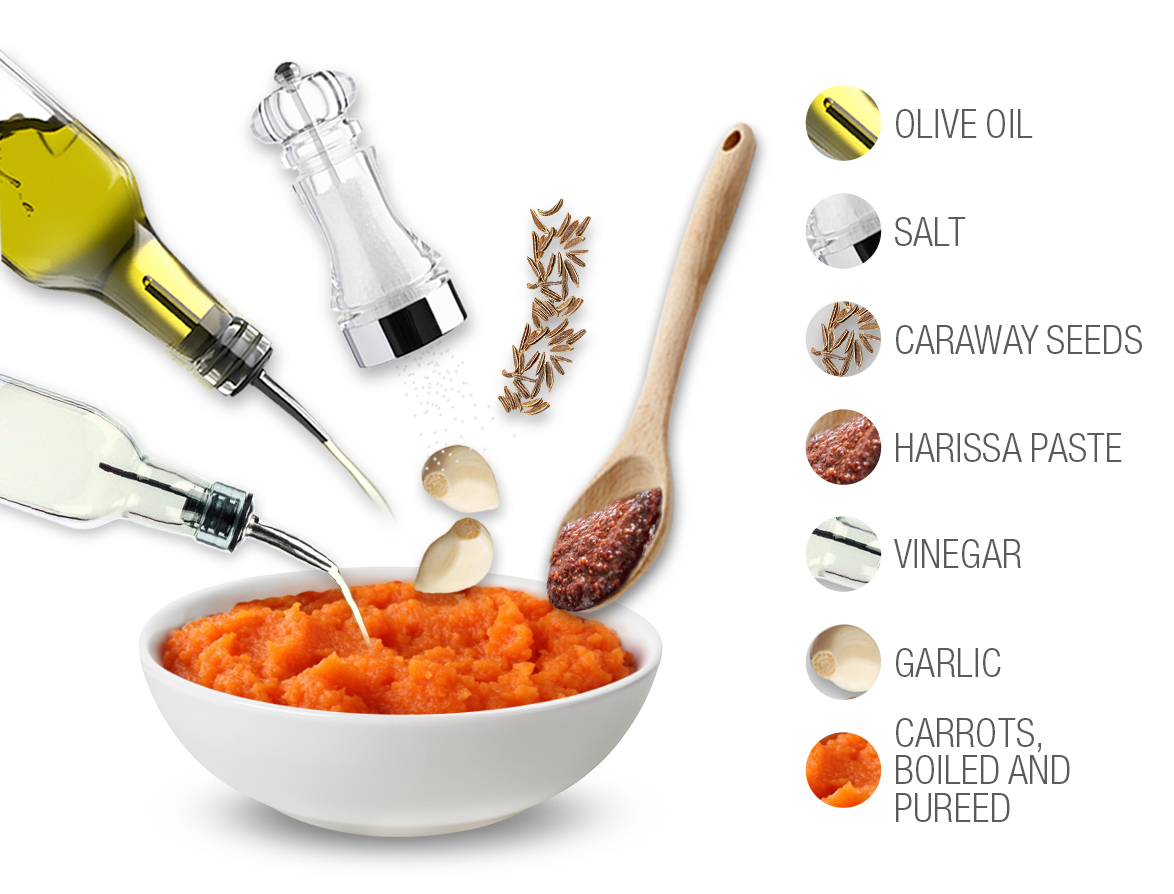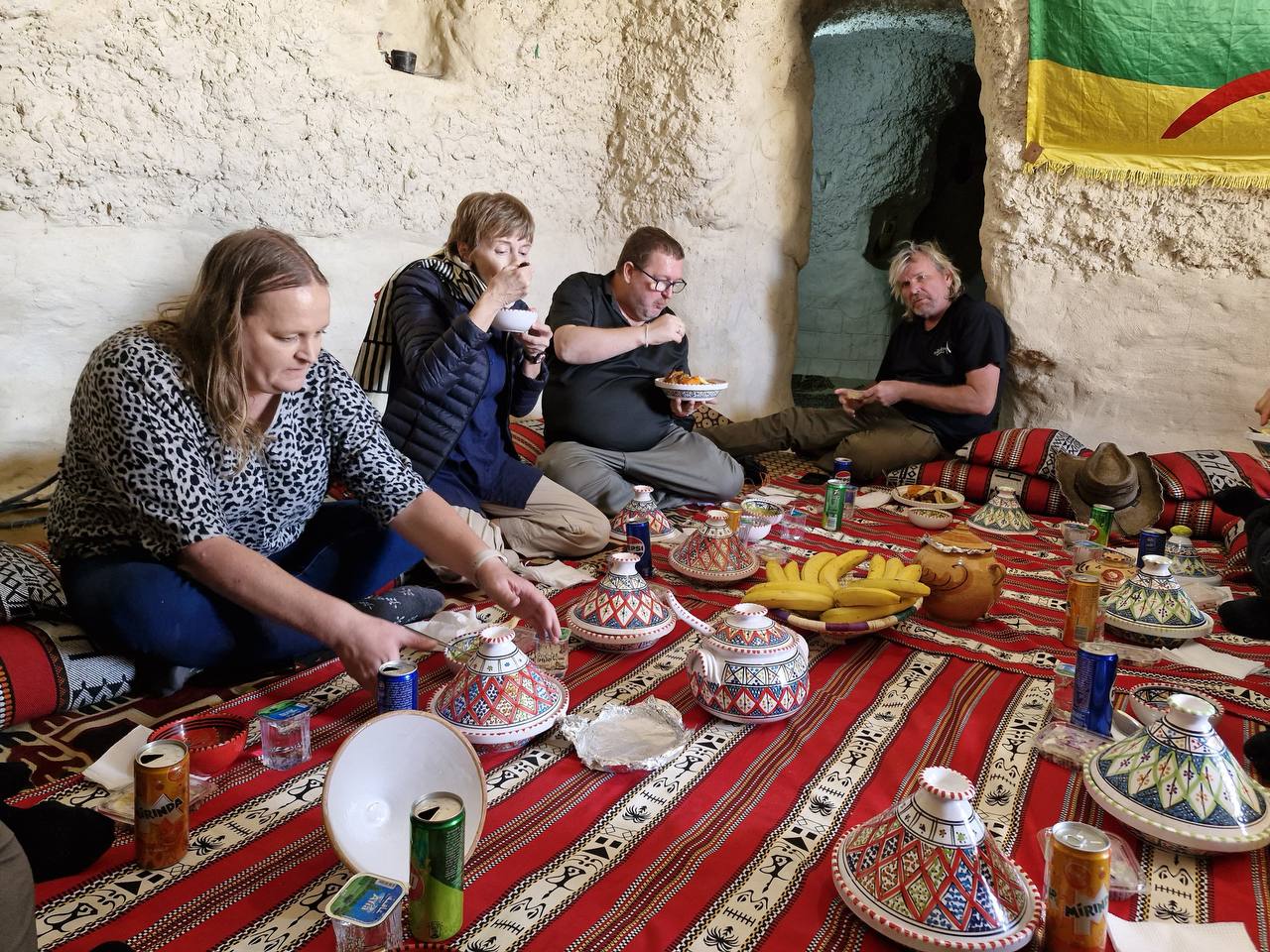Tunisian cuisine does not bother with subtlety. It is oily, spiced, messy, practical, and unapologetically direct. In the medinas of Tunis, Sousse, Bizerte, and other towns, the smell of frying oil, cumin, garlic, and seafood hits visitors before anything else. Vendors shout, scooters thread through crowds, and cats vanish under stalls. Eating here is not a polite affair. Food is everywhere, cheap, and served in portions that fill both stomach and hands.
Meals are designed to fuel and satisfy. Bread, olive oil, chickpeas, lamb, goat, and fish form the backbone of most dishes. Harissa, the fiery chili paste, is ever-present. Portions are large, spices are generous, and the chaos of the streets is part of the experience. Street food dominates, but small cafés and family-run restaurants follow the same philosophy: food must be hearty, flavorful, and cheap. Prices are absurdly low by Western standards. A fricassé costs three to four TND, a brik five to six, and lablabi five to seven, roughly one to two dollars. Visitors quickly learn that mess is expected, and clean hands are a luxury.
Table of Contents
History and Influences
Tunisian cuisine is the product of centuries of trade, conquest, and adaptation. Phoenicians planted olives and grains along the coast, creating the foundation for the local diet. The Romans refined sauces, stews, and preservation methods, introducing layered cooking techniques. Arab conquests brought spices: cumin, coriander, caraway, cinnamon, and harissa. The Ottomans added pickled vegetables and sweets. French colonization brought baguettes, pastries, and café culture, which survive in small cafés across Tunis. Sicilian traders contributed seafood methods, citrus pairings, and ideas about dessert.
Every dish tells a story of practicality and survival. Brik, fricassé, lablabi, couscous, and tagine have been refined over centuries because they work. Street food remains largely unchanged. Meals were designed to feed sailors, farmers, and traders in a hot Mediterranean climate. Modern Tunisian cuisine may look simple, but it carries centuries of history, regional adaptation, and practical efficiency.
Ingredients and Flavours
Olive oil is the cornerstone of nearly every dish. Garlic, cumin, coriander, and caraway are staples. Chickpeas, lentils, and beans provide protein for inexpensive meals. Vegetables like tomatoes, onions, peppers, and carrots are slow-cooked into stews, salads, and sauces. Lamb and goat dominate inland, while fish and seafood dominate coastal towns. Chicken appears occasionally, usually fried or in tagines. Eggs are baked into brik, tagines, and ojja. Bread is universal, often acting as both utensil and plate. Desserts are dense and functional, usually made from nuts, honey, or dates. Flavors are bold, sometimes fiery, but always straightforward.
Preservation techniques influence texture and taste. Pickled vegetables, salted meats, dried fruits, and cured fish appear in regional specialties. Harissa heat varies by location, growing hotter in the south. Coastal towns emphasize freshness, light seasoning, and citrus. Inland meals are heavier, slower-cooked, and often oily. The south favors preserved ingredients and combines sweet, salty, and spicy elements.

Regional Flavours
The north, including Tunis, Bizerte, and coastal towns, focuses on seafood. Grilled sardines, octopus, prawns, and fish stews dominate menus. Olive oil and lemon highlight freshness. Meals are lighter and cooked quickly. Central Tunisia favors lamb, goat, and beef. Couscous, tagines, and thick stews dominate tables. Chickpeas and vegetables accompany almost every meal. The south, including Gabès and Douz, relies on dates, dried fruits, preserved meats, and heavier couscous. Harissa becomes progressively hotter. Each region claims to do brik or couscous better than the others, but the reality is that each version is worth trying on its own terms.
Street Food Culture
Vendors operate from carts or small stalls selling fricassé, brik, sandwiches, chickpea soups, and small fried pastries. Customers push through the crowds. Scooters thread through the narrow lanes. Heat, smoke, and the smell of frying oil combine into an overwhelming sensory experience. Fricassé costs three to four TND, brik five to six, and lablabi five to seven. Bread accompanies nearly every dish and that is equally true for street food.
Being North African though and the climate that it brings means that street food is not as pervasive in Tunisian cuisine as say you might fund in Asia. I will give street food Tunis its own blog at some point.

Must-Try Foods 10 to 1
10 Fricassé
Fried bread rolls stuffed with tuna, mashed potato, egg, and harissa. Served hot at street stalls for three to four TND or one to one and a half dollars. Crispy outside, soft inside, messy and immediately satisfying.

9 Bambalouni
Deep-fried dough coated in sugar or honey. Two to three TND or sixty cents to one dollar. Breakfast or late-night snack. Crunchy edges, soft center, eaten quickly to avoid cooling.

8 Mloukhia
Dark green stew made from jute leaves and meat. Eight to ten TND or two and a half to three dollars. Thick, earthy, filling, sometimes divisive. A traditional specialty that rewards adventurous eaters.

7 Kafteji
Fried vegetables mixed with eggs, sometimes tuna. Five to seven TND or one point six to two dollars. Messy, heavy, intensely flavored. Street or café fare, usually eaten quickly.

6 Tagine Tunisian Style
Layered baked dish with meat, vegetables, and eggs. Twelve to fifteen TND or four to five dollars. Dense, hearty, comforting. Distinctly Tunisian, not Moroccan.

5 Brik
Thin pastry filled with tuna, parsley, capers, and egg. Deep-fried to crisp perfection. Five to six TND or one point six to two dollars. Serve immediately.

4 Slata Mechouia
Grilled peppers, tomatoes, onions chopped and mixed with olive oil. Six to eight TND or two to two and a half dollars. Occasionally topped with tuna or egg. Smoky, bright, and versatile.

3 Ojja
Tomatoes, peppers, garlic, eggs, sometimes merguez or seafood. Eight to ten TND or two and a half to three dollars. Spicy, served hot, eaten with bread to soak up juices.

2 Lablabi
Chickpeas in cumin broth over torn bread, topped with tuna and egg. Five to seven TND or one point six to two dollars. Comfort food for breakfast or after a night of drinking.
1 Couscous Tunisian Style
Steamed semolina with vegetable and meat or fish stew. Fifteen to twenty TND or five to six dollars. The cornerstone of Tunisian cuisine, hearty, practical, and satisfying.

Must-Try Drinks 10 to 1
10 Celtia
Tunisian lager. Five to six TND or one point six to two dollars. Cold, light, found everywhere, consumed casually.

9 Tunisian Wine
Red, white, or rosé from coastal vineyards. Twenty to twenty-five TND or six to eight dollars per bottle. Earthy, simple, pairs with seafood and stews.

8 Boukha
Fig-based brandy, thirty-six to forty percent ABV. Five to six TND or one point six to two dollars. Strong, aromatic, served neat.
7 Thibarine
Spiced apricot brandy. Six to seven TND or two dollars. Sweet and warming, usually drunk neat.

6 Local Beers Other Than Celtia
Stambouli and similar lagers. Five to six TND or two dollars. Simple, unpretentious, drinkable.
5 Boukha Cocktails
Boukha mixed with lemon juice or tonic. Six to eight TND or two to two and a half dollars. Often improvised in smaller bars.
4 Arak
Anise-flavored spirit. Eight to ten TND or two and a half to three dollars. Strong, often diluted with water.

3 Date Brandy
Sweet, rich, southern specialty. Six to eight TND or two to two and a half dollars. Usually consumed in small servings.
2 Wine by the Glass
Red, white, or rosé. Three to four TND or one to one and a half dollars. Quick, casual, versatile.

1 Mezze and Drinks Combo
Small servings of local spirits or wine paired with tapas-style snacks. Five to ten TND or one and a half to three dollars. Popular in evening markets and small cafés.
Eating in Context
Tunisian cuisine is messy, bold, and functional. Bread accompanies almost every dish. Harissa is omnipresent. Portions are large. Meals can be eaten standing, sitting on small stools, or in cafés. Street food dominates, yet small restaurants offer slightly calmer experiences. The combination of history, regional variation, ingredients, and street-level chaos makes Tunisian food distinct. It is not polished, it is not delicate, but it works. It feeds, it warms, it satisfies, and it reflects centuries of adaptation and survival.
Visitors who embrace mess, heat, and spice find Tunisian cuisine rewarding, chaotic, and endlessly flavorful. Markets, medinas, street stalls, and small cafés are the best way to experience it. Meals are practical, immediate, and rarely wasted. Tourists can ignore menus or follow locals. The cuisine may not impress at first glance, but it never disappoints those willing to dig in.
And if all else fails, go to Morocco…
YPT don’t do Tunisa Tours yet, but our Libya Tours do pass through.





